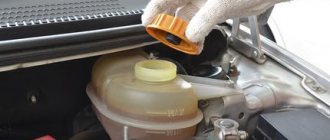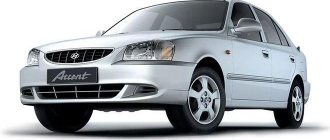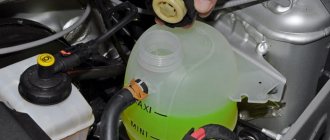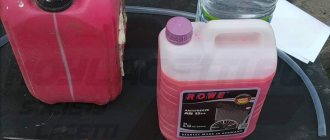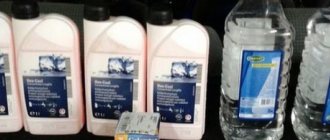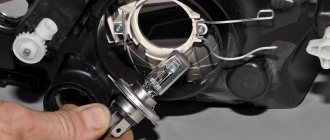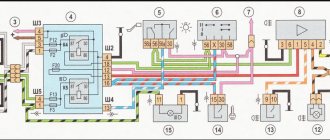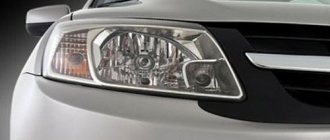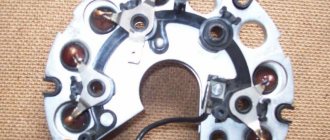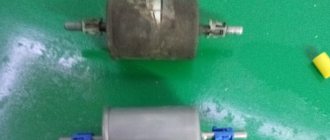Antifreeze for Opel Astra N - review
Untimely replacement of antifreeze can cause the same harm as poor quality fuel. Antifreeze is an engine coolant. A boiling engine in a traffic jam and in the heat is precisely what happens due to the lack of replacement of the coolant. You can easily change the coolant at home; the whole process will take 30 minutes. Many drivers are afraid of a trip to the service center and a long wait in line - so replacement is postponed until the very last moment. This very last moment happens, as a rule, on the roads, at the most inopportune time. How to avoid the development of such situations? Read further in the article.
When should you change antifreeze?
There are no universal replacement dates. There is a standard rule - antifreeze is replaced every 40-50 thousand kilometers. But it is recommended to do this a little earlier.
In addition, the car can be operated in different load conditions - therefore, to replace the coolant, it is better to stick to a mileage of 25-30 thousand kilometers. Visually, the need for replacement is visible if the following indicators are present:
- Opel Astra h antifreeze is running out - after the car has been parked for a long time, oil spots appear under the engine;
- On the left, under the front bumper, smudges of brown liquid appear - Opel Astra H antifreeze is leaking;
- When opening the reservoir, the color of the liquid became noticeably clearer or had a mushy consistency;
- A very bad signal if there are oil stains inside the tank. This means that the heat exchanger has leaked inside the car engine. Engine oil has mixed with coolant. In this case, immediately take the car to a service center for inspection;
- The volume of antifreeze in the Opel Astra H is on the initial fill scale;
- Since the last fill, the mileage has been more than 25 thousand kilometers;
- The engine temperature is in the red zone - the cooling mode of the engine will jam its operation. The coolant needs to be changed urgently.
Replacement process
The process of replacing the refrigerant in Opel is quite simple. In the Opel Astra J, replacing antifreeze is similar to the Opel Astra h, as is replacing antifreeze in the Opel Astra G. The listed car models have the same operating principle with replacing the refrigerant.
- We prepare a container for draining the waste liquid. You can take a simple 5 liter plastic bottle. At the top we make a hole in the shape of a rectangle 5 by 3 cm. The waste liquid will be drained into this hole;
- Turn off the engine, it is better to drain the antifreeze when the Opel has been standing for 15-20 minutes;
- We carry out the entire process on a level surface;
- Buy new coolant from trusted suppliers. Never use it by hand, where the liquid is on trays under direct influence of the sun or temperature conditions.
Antifreeze drain
How to drain antifreeze on an Opel Astra J or drain antifreeze on an Opel Astra H - processes are similar in time and complexity.
- Under the front bumper, in the area of the left headlight, we look for the coolant drain cone. We substitute the container and unscrew it;
- A thin stream of antifreeze will flow slowly. Color – brown or bright pink. Depending on the originally acquired color (indicator - the engine must be cooled with new liquid);
- Next, pour distilled water into the tank (attention: not from the tap, but purchased distilled water that does not contain chlorine deposits);
- We wash it 5-6 times. The color should be pale pink (blue, yellow);
- Cleaning is complete. We pour all waste liquid into a technical drain (not in domestic conditions - the liquid is poisonous).
Filling with new antifreeze
We select the brand of antifreeze according to the engine type:
- Marking 11: not a very high-quality liquid, fill in as a last resort. Suitable for old models of the Soviet automobile industry or foreign cars;
- Marking G12 (includes carbo-silicate) – high-quality refrigerant, suitable for engines operating at high speeds;
- Marking G13 – contains propylene glycol. It is no different from the previous type, but does not contain poisonous properties.
The color of antifreeze does not matter. They are produced in different combinations respectively. From red and pink to blue and yellow.
The best advice on choosing a coolant is Opel's recommendations. We open the Opel operating instructions on the last page - all brands of consumables are listed there in full.
I changed the antifreeze level sensor, but in vain.
I changed the antifreeze level sensor, but the message about its lack still pops up.
What kind of crap is this ? He's already sick of me. Is it really the tank? I seriously doubt it.
It's really all about the tank. If it were possible to somehow wash it out of the emulsion (usually when oil gets into the antifreeze, it settles on the walls of the tank and the magnet begins to jam and activate the sensor), then there would be no need to completely change it..
In general, Zafira B..od, not ASTRAvod.. Zafira B 1.9 CDTI (Z19DTH - 150+EDS) Black OPC Line Panorama.
Repair of a jammed ASTRA H rear windshield wiper.
The service is provided at your location.
It’s quite possible in a barrel, because there’s a float with a magnet. I just put a jumper on the sensor contacts and forgot about this message.
Everything is fine with the tank. I recently changed the antifreeze, everything was clean without deposits and the antifreeze was like new. just in case, I still thoroughly washed the tank with citric acid, especially the container with the float. The float moves freely without any snags. the only thing I can still assume is that the float loses its buoyancy properties over time and begins to sag. but I don’t even know in 4 years, could this happen? The most interesting thing is that the message pops up only after driving over large bumps, when there is a strong build-up of the car.
. Yes, yes, I had the same thing, in short, I got tired of this message “beat off” every time - I put a jumper. And they already wrote about this https://astraclub.ru/threads/34937-Insatiable-antifreeze-sensor-(Coolant-level-check)!!
If I needed a jumper, I wouldn't order these options at all. there is a sensor - that means it needs to work.
Have you checked the sensor with a tester to see if it is working properly? By the way, it could also be a problem with the connectors/wiring.
Try adding a little antifreeze.
The sensor is completely new. By the way, I added a little frieze, so far it hasn’t come out for a couple of days. but the cold level is 1 cm higher than the COLD strip.
It's clear that it's new. How does this guarantee its functionality and wiring integrity?
It's simple. Inside the sensor is a reed switch, which closes the contacts under the influence of the field of a conventional magnet (in the tank). The new sensor may be faulty (the reed switch legs are not soldered, the reed switch bulb is cracked, etc.). Therefore, we call the tester, bring some kind of magnet to the sensor, the circuit is closed (by the way, you can even hear a click), which means the sensor is working. Next, we close the sensor connector on the car (as they wrote here, for example, with a paper clip, only securely), if the inscription on the BC disappears, only the reservoir remains (if the level is really normal).
The inscription appeared chaotically for me, I disassembled the sensor (although this is not very easy) - the reed switch leg was poorly soldered, it either shorted or not (the leg dangled together with the solder). I soldered it and put it back together for 1.5 years, everything was fine.
Guys, please tell me what needs to be filled in. please advise the brand. I have pink or red antifreeze. and in general, you can just top it up and that’s it?? Or do I need to drain it completely from the system??
Antifreeze 19 40 663 *concentrate, red, 1 liter* Antifreeze 19 40 678 *Opel, concentrate, red, 5 liters* Antifreeze 19 40 672 *Opel, ready, NOT CONCENTRATE, 5 liters*
Stages of replacing coolant Opel Astra H
In this model, antifreeze is drained through a special drain valve located at the bottom of the radiator. But there is no provision for draining the engine block, so it would be logical to perform a flush. This will completely eliminate the presence of old fluid in the system and will not worsen the properties of the new antifreeze.
As you know, the GM corporation includes many brands, and therefore the car was supplied to different markets under different names. Therefore, according to these instructions, you can perform replacement on the following models:
- Opel Astra H;
- Opel Astra Classic 3 (Opel Astra Classic III);
- Opel Astra Family;
- Chevrolet Astra;
- Chevrolet Vectra;
- Vauxhall Astra H;
- Saturn Astra;
- Holden Astra.
Replacement frequency, what antifreeze to fill
The first replacement of antifreeze in this model is made after 5 years of operation. Next, replacements must be made based on the recommendations of the coolant manufacturer. Using products manufactured using modern technologies from well-known brands, this period will also be at least 5 years.
It is recommended to use General Motors Dex-Cool Longlife as a fill-in antifreeze. Which is an original product with all the necessary approvals. Articles by which it can be ordered are 93170402 (1 l.), 93742646 (2 l.), 93742647 (2 l.).
Its analogues are Havoline XLC concentrate, as well as Coolstream Premium, a ready-to-use product. Coolstream is supplied to conveyors for filling into new cars assembled in Russia.
The main criterion in choosing a coolant for Astra N is GM Opel approval. If the liquid has it, then it can be used. For example, an excellent analogue for this model would be the German antifreeze Hepu P999-G12.
How much antifreeze is in the cooling system, volume table
| Model | Engine capacity | How many liters of antifreeze are in the system | Original liquid / analogues |
| Opel Astra N | gasoline 1.4 | 5.6 | Genuine General Motors Dex-Cool Longlife |
| gasoline 1.6 | 5.9 | Havoline XLC | |
| gasoline 1.8 | 5.9 | Coolstream Premium | |
| gasoline 2.0 | 7.1 | Hepu P999-G12 | |
| diesel 1.3 | 6.5 | ||
| diesel 1.7 | 7.1 | ||
| diesel 1.9 | 7.1 |
Leaks and problems
The cooling system of the Astra AS is sealed, but over time, leaks may occur in various places through which antifreeze escapes. If detected, you should pay attention to the pipes and connections. There is also a leak where the throttle valve is located.
Some car enthusiasts find oil in antifreeze; there can be many reasons for this, including a broken gasket. But accurate information can only be obtained from the service, with a detailed study of the problem.
Choosing a coolant is not difficult
All Opel Astra Ns require red antifreeze; over long periods of use it will lighten to orange or yellow. And under no circumstances should you use green or G11 antifreeze. Because of this, the entire system can fail. In principle, the coolant should be replaced at least once every two to two and a half years.
, or at least every 40,000 km, this is important, because after this period the antifreeze will lose its properties and will no longer be able to cool.
What are the main properties of coolant?
Possesses anti-corrosion and lubricating properties.
Consists of H 2 O and ethylene glycol - a synthetic chemical.
Does not freeze at – 60 C.
Boiling point +108 C.
Coolants are also required for warming up, in order to heat rather than cool the engine. We must not forget that mixing different types with each other is not allowed.
and antifreeze with Tosol (antifreeze is the trade name for coolant based on ethylene glycol, sometimes numbers are added to the name).
In addition to replacement due to loss of unique cooling properties, it is possible in case of engine repair. In no case should you lose sight of the fact that replacement can only be done on a cold engine.
How is the coolant changed on an Opel Astra?
You will know that replacement is necessary when the fluid becomes dull or loses its color.
If you are going to change the type of coolant, be sure to rinse the radiator with plain water.
The engine should be cold and make sure the car is on a level surface.
It is necessary to open the tank and, putting a hose on the drain valve, empty the cooling system.
Antifreeze is poured into the Opel Astra until it drips from the pipe.
Afterwards you need to warm up the engine and check the level in the tank; if there is a shortage, add more.
content .. 18 19 20 21 ..Opel Astra H. Reduced coolant level
| Replace damaged parts | ||
| Liquid leakage through the coolant pump seal | Inspection | Replace the pump |
| The cylinder head gasket is damaged. Defective block or cylinder head | There is an emulsion with a whitish tint on the oil level indicator. There may be abundant white smoke from the muffler and oil stains on the surface of the coolant (in the expansion tank). Coolant leaks on the outer surface of the engine | Replace damaged parts. Do not use water in the cooling system, fill with coolant appropriate to the climatic conditions |
Reasons for a drop in
the coolant level in the expansion tank (decrease in antifreeze level)
A change in the coolant level is quite natural. When the engine is cold, the level decreases, and when the engine is warm, the level increases. Similarly, the level changes depending on the ambient air temperature. In winter, the volume in the expansion tank becomes smaller, and in summer it becomes larger. But what if you begin to notice a constant decrease in the volume of liquid in the tank. There are other reasons for the decrease in antifreeze levels, which are caused by the malfunction of certain components in the cooling system.
The first thing a car owner should do to find out the reasons is to determine the location of the leak. To do this, when you park your car in a garage or parking lot overnight, place a clean white piece of cardboard under the hood. In the morning, look carefully to see if there is liquid on the paper and in what area. Typically, the leak occurs either under the radiator or under the engine, where there is a pump (water pump) that pumps antifreeze through the system.
Very often, leaks are caused by loose hose clamps. Use a flashlight to inspect the engine compartment and, if possible, drive the car onto an overpass or pit to get a good inspection under the hood. Check where the clamp holds the hose. If the reason is in the clamps, then you will quickly find a constantly damp place from where antifreeze leaks. In this case, you should replace the clamp with a new one and check if there is any leakage after this. If all the clamps are dry and the decrease in the antifreeze level continues, then you should check the pump. Often, this pump that pumps antifreeze through the system fails, especially if it is of poor quality. The pump is replaced every 50-60 thousand km, although many car owners wait until it breaks down and only then contact a car service center. You can notice a pump malfunction by the following signs: — the area around the pump and drive belt is constantly wet; — the stove in the cabin began to heat poorly; — remove the drive belt and try to rotate the pulley. A loose pulley is a sign of a malfunction; — the appearance of a clearly visible gap in the pulley drive is the most likely sign of a pump malfunction or that the pump will soon fail. A characteristic sign that the pump has already failed is, in addition to antifreeze leakage, a constant knocking sound while the engine is running. The source of the knocking is faulty pump bearings.
If you do not notice all of the above signs, check the condition of the radiator. Indirect signs of a radiator failure are: - antifreeze stains under the hood in the radiator area; — constant fogging of the windshield; — in the front passenger area there is a constant appearance of oil stains on the floor. If these signs are detected, repairs at a service station are required.
A decrease in antifreeze level can occur if the cylinder head gasket is broken. If this part breaks, coolant begins to enter the oil channels. A characteristic sign is the appearance of white smoke from the exhaust pipe and the appearance of transparent bubbles on the oil dipstick. If these signs are detected, you should contact a car service center and do not operate the car. When antifreeze gets into the oil, it reduces its lubricating properties, which over time can cause the engine to overheat and break down.
Evaporation of antifreeze and other causes of its leakage
Antifreeze is a substance used in the cooling system of vehicles, characterized by a high boiling point and low freezing point. Now there are three main colors - red, green and blue.
The basis of this composition is a glycol-water mixture, which determines the property of antifreeze not to freeze at subzero temperatures. Among domestic manufacturers, the most common are ethylene glycol-based products. However, an aqueous solution of such a substance is quite aggressive towards some materials of the car cooling system.
To prevent damage to parts, this substance also contains various additives: anti-corrosion, stabilizing, anti-foaming.
Common cooling system failure
The most common breakdown of a car's cooling system is a decrease in antifreeze levels. Signs of this problem are:
A large amount of steam coming out from under the hood; White smoke coming out of the car muffler; The stove reduces the air temperature in the cabin, rather than increasing it; The instrument panel indicates engine overheating; The thermometer in the car has reached its maximum value. Sometimes even several signs appear at the same time, in which case the car must be turned off immediately and provided with maintenance at a service station.
Why does the antifreeze level decrease?
A decrease in the level of antifreeze in the coolant reservoir is a fairly common phenomenon nowadays. This can happen for several reasons:
During the cold season, the coolant tends to decrease in volume. Therefore, in winter this substance should be added more often than at other times.
Liquid passes into cracks and crevices of the tank or its lid. Detecting such problems can be quite difficult, because cracks in appearance can resemble ordinary scratches. However, this may be sufficient for a slight loss of antifreeze from the tank. leaves the tank
Depressurization of various connections of the cooling system or damage to its tubes and hoses. Leaks also occur with the thermostat gasket. Various radiator breakdowns can also cause a decrease in coolant level. radiator leaking
Another reason for antifreeze leaving the vehicle system is its evaporation. Any coolant contains water, which, even despite the tightness of the cooling system, gradually evaporates from it. Experts note that a decrease in the fluid level in such an automobile system by about 200 grams between two adjacent scheduled maintenance is the norm.
Thus, even in the absence of any damage, antifreeze gradually evaporates from the car’s cooling system, although this occurs in very small volumes.
If the coolant leaves quickly enough, the reason lies not in evaporation, but in some other problem, so you should immediately go to a service station for professional help.
If it is not possible to use the services of a car service when the antifreeze “leaves”, you can try to determine the cause of this problem yourself.
First of all, you should check the oil with the engine not running - remove the dipstick and carefully inspect it for traces of any liquid other than oil.
After this, start the engine and leave it running until the fan comes on. In this case, it is necessary to monitor the cooling system to see if drops of liquid appear somewhere, especially at the joints and hoses. There is a small chance that the problem may lie in the radiator, but it is very difficult to determine this on your own.
It would also be useful to check the tightness of the tank closure. Typically, in this case, light vapor will be noticeable coming out from under the hood, and characteristic traces of liquid evaporation will remain on the tank.
Another reason why coolant will leak very quickly from the system is a broken cylinder head. It is clear that such a malfunction cannot be identified and eliminated on its own.
Another way to determine the problem yourself is to leave a sheet of cardboard under the hood overnight. If antifreeze leaks, traces of it will be visible on the cardboard.
content .. 18 19 20 21 ..
Antifreeze for Opel Astra H
When purchasing, you need to know the shade - Color
and
The type of
antifreeze allowed for the year of manufacture of your Astra H. Select the manufacturer at your discretion. Do not forget - each type of liquid has its own service life.
For example:
for an Opel Astra (Body H) 2004, with a gasoline or diesel engine, a carboxylate class of antifreeze, type G12 with shades of red, is suitable.
The approximate time for the next replacement will be 5 years. If possible, check the selected fluid to ensure compliance with the vehicle manufacturer's specifications and maintenance intervals. Important to know
Each type of liquid has its own color. There are rare cases when the type is tinted with a different color. The color of red antifreeze can be from purple to light pink (green and yellow have the same principles).
It is possible
to mix liquids from different manufacturers if their types meet the mixing conditions.
G11 can be mixed with analogues of G11 G11 cannot be mixed with G12 G11 can be mixed G11 can be mixed with G12++ G11 can be mixed with G13 G12 can be mixed with analogues of G12 G12 cannot be mixed with G11 G12 can be mixed with G12+ G12 cannot be mixed with G12++ G12 cannot be mixed with G13 G12+ , G12++ and G13 can be mixed with each other. Mixing Antifreeze with Antifreeze is not allowed.
No way! Antifreeze and Antifreeze differ greatly in quality.
Antifreeze is the trade name for the traditional type (TL) of old-style coolant. At the end of its service life, the liquid becomes completely discolored or becomes very dull. Before replacing one type of fluid with another, rinse the car radiator with plain water. . Additionally
How to select and replace
Opel Astra
antifreeze Opel Astra antifreeze models H and J. Replacement rules, instructions for draining and filling, as well as useful tips on the Astra cooling system.
How much does one liter of antifreeze cost?
200 rub. Green color; Antifreeze type
— G11; Crystallization temperature -40C. Designed for use in all cars and trucks. RUR 396/pcs.
Interesting materials:
Where can I pay the state fee without commission? Where to pay the state duty at the traffic police? Where can I pay the state duty for a car? Where can I pay the state fee for the traffic police exam? Where can I pay the state fee for obtaining a driver's license? Where can I pay the state fee for registering a car? Where can I pay the state fee for a license without a commission? Where to pay the state fee for a license at the traffic police? Where can I pay the state fee for my license? Where can I pay the state fee for replacing my driver's license?
Replacing antifreeze Opel Astra H
According to the rules, antifreeze in Astra is changed every 45 thousand km or every 2 years.
You don't need special skills or equipment to replace yourself. Any work with coolant can be done with the engine cooled. The vehicle must be on a level surface.
- First open the expansion tank
- Then you need to put a hose on the radiator tube of the drain valve, insert the end into the drain container and turn the valve.
- To completely drain the cooling system of your Opel Astra, you must move the clamp holding the throttle body heating pipe and remove the pipe from the intermediate pipe socket.
- Fill until it evaporates from the remote nozzle. Then install it in place. Then you need to let the engine warm up to operating temperature and check the level in the expansion tank. If the level is below the required level, top up.
Engine flushing instructions
It is recommended to clean the system with a special flush “Valvoline Radiator Flush” or any other flush designed for Opel car engines.
- Pour the flushing mixture directly into the coolant reservoir.
- Start the engine and leave it running at idle speed for up to 15 minutes.
- Then turn off the car and wait until it cools down completely (40 minutes)
- Unscrew the tank cap.
- Place the hose onto the drain hole in the radiator (located at the bottom right).
- Unscrew the red nut with a flat blade screwdriver. It is not necessary to unscrew completely.
- Wait until the refrigerant has completely drained out.
- Now you need to remove the throttle body heating hose. Before this, it is recommended to dismantle the engine protection, since what flows out of the hose will flow directly onto the protection.
- After removing the hose, it must be lowered to the level of the tank and wait until the liquid is completely drained from it.
- After such a procedure, it is necessary to rinse the motor system with ordinary distilled water. First, screw that red nut into the radiator from the bottom.
- Put the throttle body heating hose back on.
- Pour water into the tank right up to the lid.
- Start the engine and leave it running until the fan turns on.
- Repeat the procedure as many times as necessary until clean water begins to flow out of the tube and drain hole (usually 2-3 repetitions are enough).
- Fill with new antifreeze.
Replacing antifreeze Opel Astra J
The Opel Astra J coolant should also be replaced every 45,000 km or every 2 years.
During the procedure, the car must be on a flat surface. The process algorithm looks like this:
- First of all, open the expansion tank cap.
- Connect the hose to the drain hole and place the end in a container to drain.
- Open the tap.
- Fill the new product until it runs away from the throttle valve, it must be removed in advance by loosening the clamp.
- Check the level on a warm engine and top up if necessary.
Instructions for adding new refrigerant
- Wait until the engine has completely cooled down.
- Remove the reservoir cap.
- Fill in new fluid mixed with water (different fluids are mixed in different ratios, but usually it is 50 to 50) to the Kalt/Cold mark.
- Start the engine and leave it running until the fan turns on (no more than 15 minutes).
- Shut off and check the fluid level. If necessary, top up.
- Check the amount of fluid after 50 and 100 km of travel and top up if necessary.
Why does antifreeze go away?
Such reasons for the Opel Astra
enough. Coolant may be leaking from the radiator, pump, or cracked hose. Alternatively, the gateway could be the cause. If the leak is small, it will help to remove special chemical compounds that are poured into the Opel Astra expansion tank and plug small holes. But this is a temporary solution.
To avoid air congestion in the system during filling, it is necessary to periodically heat the radiator pipes.
If it changes color a few days after replacing the antifreeze, then it is a fake product and should be drained immediately.
If the Opel Astra
is heavily soiled or
the antifreeze
has not been replaced for a long time, it is recommended to flush it. There are special chemical compounds for this.
After draining the coolant, the system is filled with a flushing composition and turns on for about 30 minutes at maximum heating. The composition is then drained and the refrigerant is poured out.
Replacing Opel Astra N antifreeze is important for optimal engine performance. In the Astra N cooling system, it is allowed to use only red (dark orange) antifreeze, which, with prolonged use, can turn yellow. Recommended Opel - 1940650 or 09194431.
What is coolant and where to put it
You need to understand how often replacement is required. Firstly, such a change is necessary for optimal engine operation.
. That is, this is a coolant that needs to be poured into the cooling system of your car. It moves between the radiator and the system, removing excess heat and, as it were, making sure that the engine does not overheat. Another important factor is that it will not freeze even in severe frost.
Replacement frequency and volume of antifreeze Opel Astra N
The Opel Astra N maintenance regulations require checking the level and color of the coolant every 15,000 km. Replacement should be made when the liquid has changed color significantly, the level and density have changed. Some drivers prefer not to bother with the question of “when to change antifreeze” and replace it every 45,000 km. In any case, regardless of mileage, the coolant should be changed every 2 years
, since after this time the anti-corrosion additives lose their properties.
How much antifreeze to fill

